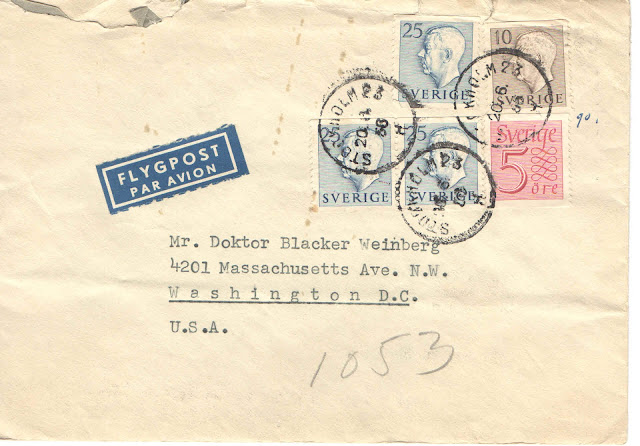The changing colours of 25 öre
This letter cover is not of the best quality. A little shredded and stained, blurry cancellation . . . Ah well, lets have a closer look. Five stamps from the 50s. Three 25 öre blue Gustaf VI Adolf type I, one 10 öre Gustaf VI Adolf and a 5 öre red New Numeral Type type I. The sum is 90 öre and there is also a note about that on the right of the stamp cluster. The label tells us that this postal item is an air mail. That seems correct since the postage rate for airmail to North America was 90 öre between September 1952 and June 1962.
The 25 öre denomination of the Gustaf VI Adolf type I series came in four different issues. Some what of a record having in mind that the type I existed just between 1951 and 1956, a mere six years. The first 25 öre stamp from 1951 was grey. Its single use was domestic letter - 20 g. A year later the 25 öre red showed up in July and the reason was that the rate for international postcards was raised from 20 öre to 25 öre. The rate for domestic letter - 20 g was untouched. The stamps for international postcards have to be red since Sweden still complied to the UPU-colours of international mail which stated that the colour has to be red and no other denomination could be red. The effect of following these rules have been presented in this blog post. The red 25 öre was one of the last Swedish stamps to follow the UPU rules since Sweden abounded this practice in 1953. The next 25 öre stamp became blue and arrived in early 1954. There were no raises in the postal rates to trigger a change in colours. Instead the Swedish Post was a little bit unhappy with shades of the colours of the whole series. They thought that the previous colours often was to light and shallow. Finally in June 1957 a fourth 25 öre stamp was issued, this time in a brown colour. It was issued at the same time as the first stamps of the the new revised type II series. That is pretty strange - to issue both old and new stamps. What was the reason? You can find a part of the explanation in the next paragraph. The brown 25 öre was replaced with the 25 öre brown Gustaf VI Adolf type II in October 1957
However the blue 25 öre set a new standard for the colouring of the denomination for the domestic letter - 20 g (the most common postal rate), not unlike the UPU-colouring practice that was just abounded. It became blue for the years to come resulting in 30 öre, 35 öre, 40 öre and 45 öre blue stamps, until March 1969, when the new stamp for domestic letter first weight class, the 55 öre Gustaf VI Adolf type III, became red. The postage rate for was raised from 25 öre to 30 öre in July 1957. The new 30 öre became blue to mark that this denomination was for domestic letter first weight class. The old 25 öre blue had then to be cancelled and was replaced by the 25 öre brown. Maybe the decision of keeping the blue colour for the most common rate was made pretty quickly and there was no possibility to engrave a new 25 öre in the type II version of the series? I think that is a likely explanation.
The 10 öre changed colours only once. The first 10 öre was green and had to be coloured that way because it single use was international printed matter, even if the rate was still 10 öre it got its new brown colour in April 1954.
The letter was sent on Wednesday 20 June 1956 and the stamps were cancelled at the Post Office Stockholm 23 at 16 Yngliga Saga Street (Ynglingagatan 16), the Ynglinga saga is an old Icelandic traditional folk saga. We have had a postal item sent from that Post Office before, look here.
The back of the cover tells us that the sender was Dr. Jakob Möllerström. He was quite famous and he is regarded to be the father of Swedish biochemistry, he did biochemical studies already in the 20s and was internationally recognized for his research. His son became quite successful also, but in another field, as a composer of music and later professor. His name was Bengt Hambreus.

No comments:
Post a Comment